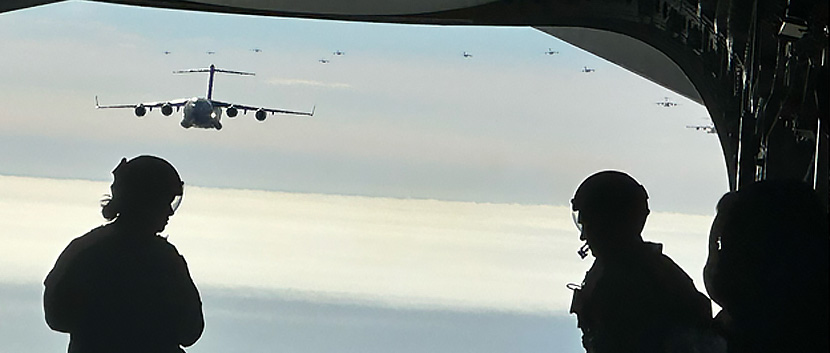
Enroute Mission Command (EMC) provides short notice units, such as the XVIII Airborne Corps, with the critical in-flight mission command and plane-to-plane/plane-to-ground network communications they need to be successful in joint forcible entry operations.
EMC improves the Army’s ability to combat sophisticated threats by enabling commanders to continue to refine their products and plan the mission as they approach their objective, receiving the critical intelligence they need to be effective and lethal. The system’s suite of network communications capabilities provide commanders with the same mission command capabilities they would use in a command post on the ground, in essence, turning the plane into a flying command post. The real-time situational awareness enables early entry forces to be better prepared and to adjust courses of action as needed, prior to combating near peer adversaries on the ground. Once boots hit the ground, they can immediately begin executing the mission.
Units like the XVIII Airborne Corps’ Immediate Response Force must be able to rapidly deploy anywhere in the world with little notice and with as much situational awareness as possible. By leveraging technologies similar to those used by today’s commercial airlines to provide inflight internet access, EMC enables these units to access mission command capabilities, including Advanced Field Artillery Tactical Data System, and secure reliable voice, video and data communications, all from an Air Force C-17 aircraft. Because of the increased bandwidth the system provides, commanders enroute to an objective can tap into mission command applications and utilize services such as Secure Voice over Internet Protocol phone calls, chat and email.
Additionally, EMC capabilities increase the reliability of unit communications between aircraft. Soldiers operating EMC can extend the same enroute communications, enhanced situational awareness and planning capabilities to other planes that are flying to the mission, enabling all forces to remain synchronized.
The comprehensive real-time situational awareness and operational understanding provided by EMC can be critical to the effectiveness of the unit in the initial stages of early entry operations.
Main Components
- The Fixed Installed Satellite Antenna (FISA) provides tactical network connectivity on select Air Force C-17 aircraft. Once EMC’s FISA is integrated onto a C-17 aircraft, Soldiers merely roll-on the other EMC equipment, and roll it off at the end of the mission. Project Manager (PM) Tactical Network fields and manages the EMC equipment for the Army and is working with the Air Force to transition the current C-17 Ku-band (commercial satellite) FISAs to commercial Ka-band; this upgraded capability is known as the Fuselage Mount Antenna (FMA). The commercial Ka-band provides dedicated bandwidth, improved service, and better worldwide coverage at a comparable cost.
- The Key-leader Enroute Node (KEN) provides airborne units with broadband reach-back data capability; intra-aircraft data and voice communications with subordinate units, Secure Video Teleconferencing and SVoIP, plane-to-plane and plane-to-ground communications between task force commanders and combatant commanders.
- The Dependent Airborne Node (DAN) enables subordinate commanders that are flying in formation (connected with their leaders operating a KEN) to receive critical situational awareness updates through the intra-aircraft data and voice capability. Through the DAN, commanders can utilize services such as chat and radio voice in order to maintain the lines of communications with their leaders and peers within the same flying formation.
- The Command And Staff Palletized Airborne Node (CASPAN) coupled with the KEN provides the Airborne task force commander and his staff with a complete platform in which they can conduct mission planning while enroute to the target area. In addition to EMC’s individual workstations, this large roll-on/roll-off workstation is designed for in-flight mission command collaboration. The CASPAN has ten seat positions, four LED screens, ruggedized laptop computers, headsets, and provides adequate bandwidth to support a prioritized set of mission planning applications